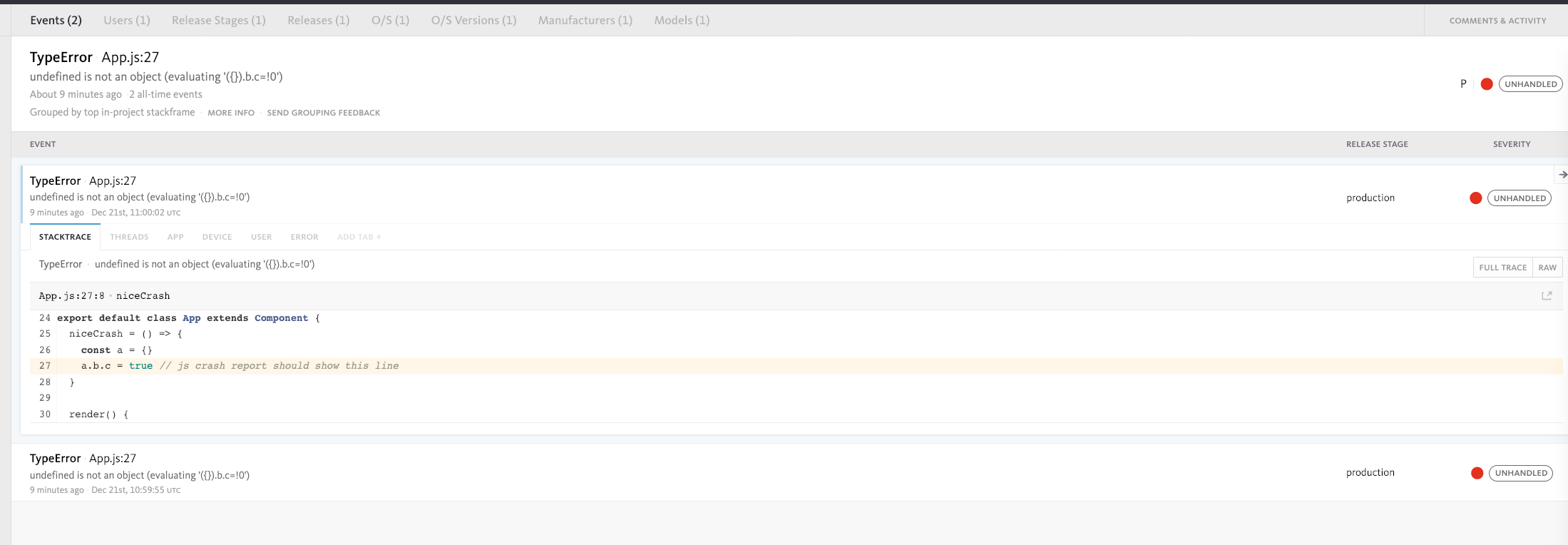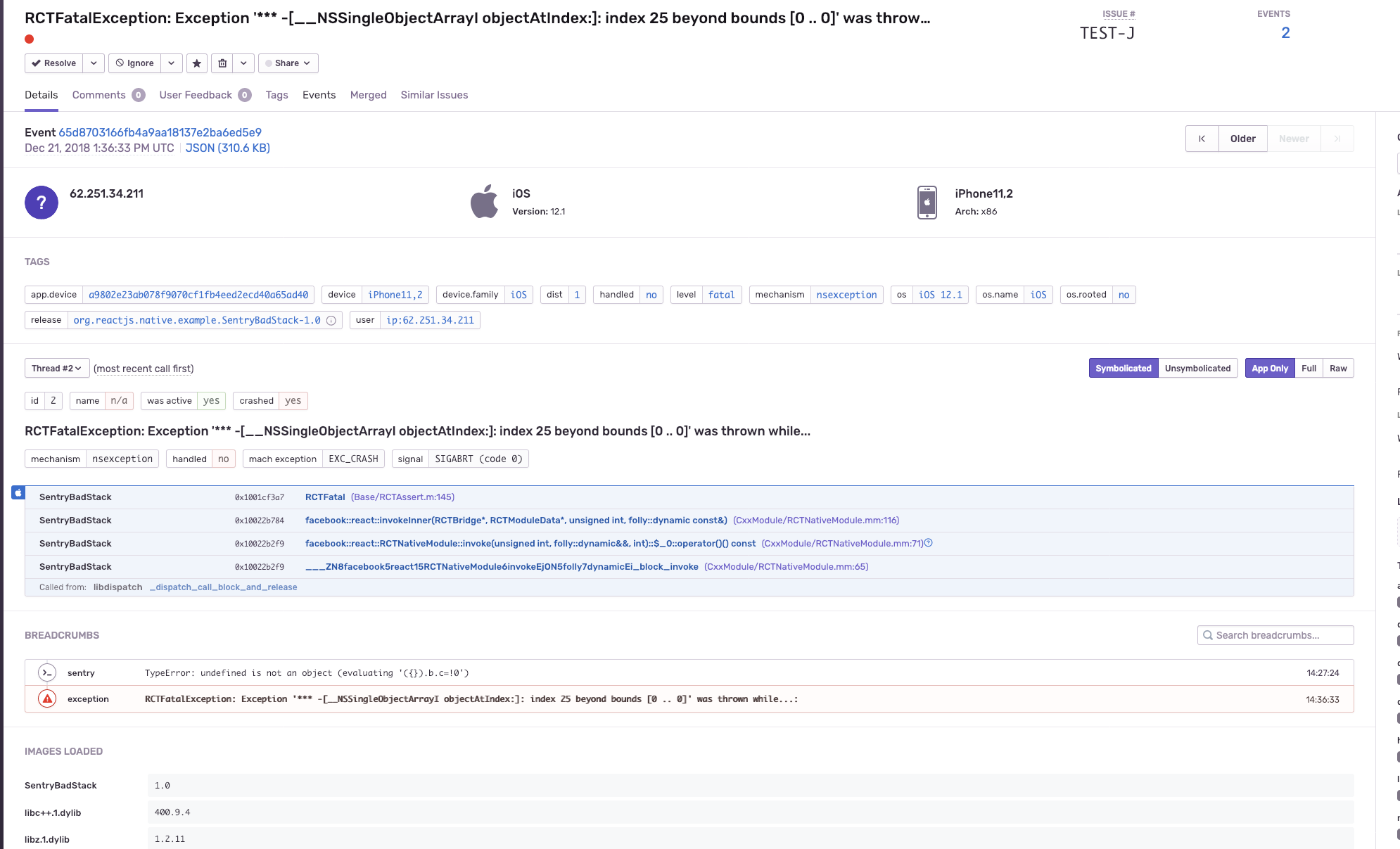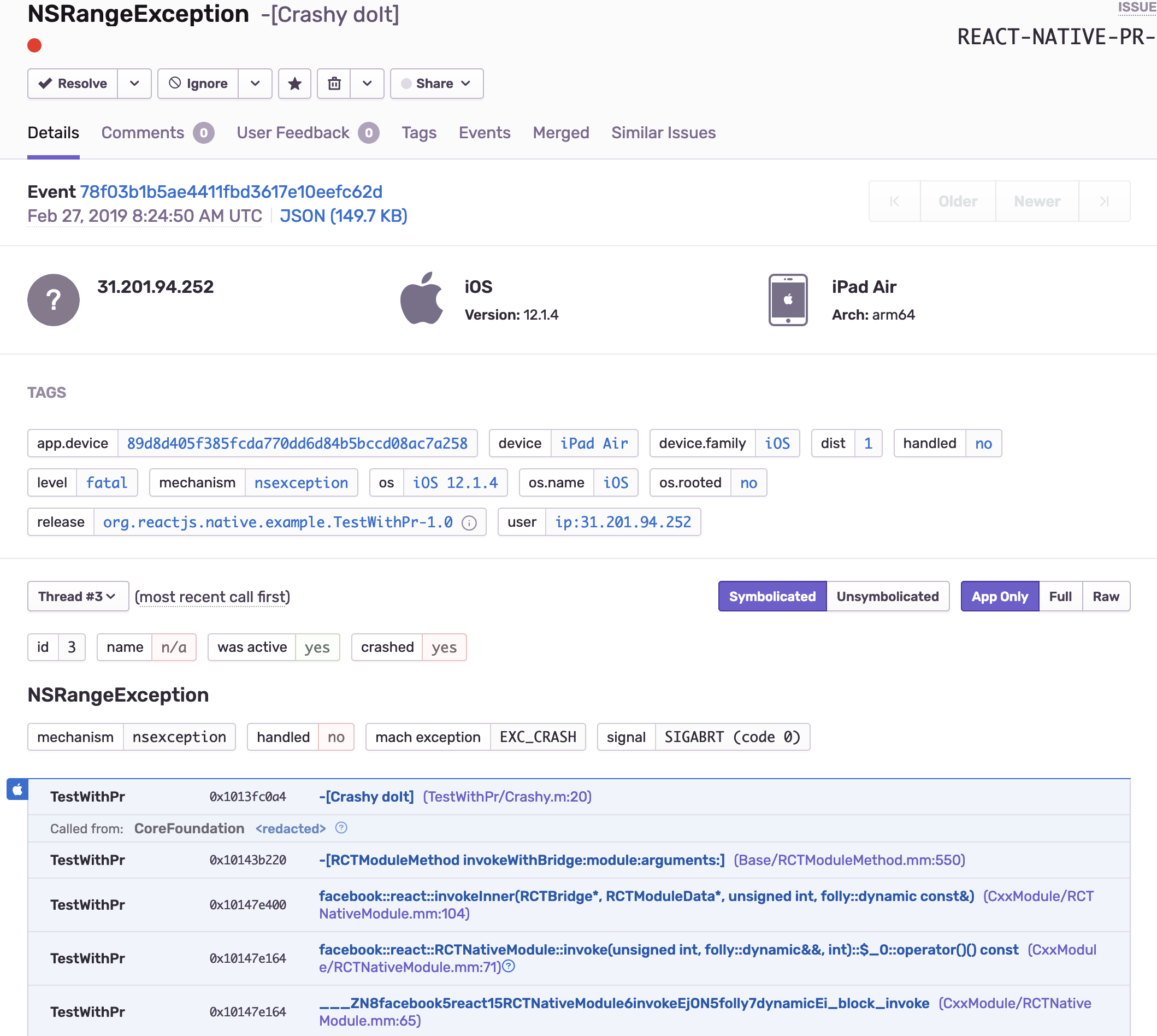-
Notifications
You must be signed in to change notification settings - Fork 24.5k
New issue
Have a question about this project? Sign up for a free GitHub account to open an issue and contact its maintainers and the community.
By clicking “Sign up for GitHub”, you agree to our terms of service and privacy statement. We’ll occasionally send you account related emails.
Already on GitHub? Sign in to your account
Crash reporting heaven #23691
Crash reporting heaven #23691
Conversation
… from native ios modules, before losing the context by converting it to an NSError
There was a problem hiding this comment.
Choose a reason for hiding this comment
The reason will be displayed to describe this comment to others. Learn more.
Code analysis results:
eslintfound some issues. Runyarn lint --fixto automatically fix problems.
There was a problem hiding this comment.
Choose a reason for hiding this comment
The reason will be displayed to describe this comment to others. Learn more.
Code analysis results:
eslintfound some issues. Runyarn lint --fixto automatically fix problems.
There was a problem hiding this comment.
Choose a reason for hiding this comment
The reason will be displayed to describe this comment to others. Learn more.
Code analysis results:
eslintfound some issues. Runyarn lint --fixto automatically fix problems.
|
Maybe @HazAT and @fractalwrench are interested in this too. |
There was a problem hiding this comment.
Choose a reason for hiding this comment
The reason will be displayed to describe this comment to others. Learn more.
This is amazing. Thank you so so much for doing all this work. I think this is going to be huge for the community.
I'm wondering if (as a follow-up) there is any possibility of adding an automated test for this so we ensure this doesn't ever regress again. I realize it may be hard to do so I'm happy to hear ideas you may have.
I'm gonna import and try to land it, but I need to check if this is gonna cause any trouble at FB :)
There was a problem hiding this comment.
Choose a reason for hiding this comment
The reason will be displayed to describe this comment to others. Learn more.
@cpojer has imported this pull request. If you are a Facebook employee, you can view this diff on Phabricator.
|
Hm I will take a look for adding tests. I might need some help/guidance for this, but I will look. |
|
Would I test the native module in a try-catch and check the exception there, or would I test in js by calling the native module and do the try-catch dance there? 🤔 |
There was a problem hiding this comment.
Choose a reason for hiding this comment
The reason will be displayed to describe this comment to others. Learn more.
@cpojer has imported this pull request. If you are a Facebook employee, you can view this diff on Phabricator.
|
@pvinis Awesome work! |
|
This pull request was successfully merged by @pvinis in 629708b. When will my fix make it into a release? | Upcoming Releases |



Summary
I have used RN for a long time, and for all this time, crash reporting has been less great than native development crash reporting. At some point, companies like sentry, bugsnag and a bunch of others started supporting sourcemaps for js crashes in RN, which helped a lot.
But native crashes were (and still are) much harder to diagnose.
..Until now :D
I have make a repo of a sample RN app, included this PR in it, and some code and screenshots to help.
The repo is here.
Explanation
I was trying to get good crash reports from native crashes in iOS for a looong time. I spoke with people in sentry, in bugsnag and more, and I could not get this solved. There was no clear way to get the native crashed to display correctly.
I made two repos here, one for sentry and one for bugsnag, demonstrating the correct js handling and the bad native handling.
After all this, and talks with their support, twitter etc, I investigated further, on why this was happening. I thought there must be some reason that native crashes look bad in all the tools, and in the same way. Maybe it's not their fault, or up to them to fix it, or maybe they didn't have the experience to fix it.
In a test project I created, I checked what's up with the
RCTFatalException, and I found out that the React Native code is catching theNSExceptions that come from any native modules of a RN app and converting it into an string and sending it toRCTFatalthat created anNSErrorout of that string. Then it checks if the app has set a fatal error handler and if not, goes ahead and throws thatNSError.The problem here is that
NSExceptionhas a bunch more info that the resultingNSErroris missing or is altering. Turning the callstack into a string renders crash reporting tools useless as they are missing the original place the exception was thrown, symbols, return addresses etc. In both repos above it can be seen that both tools were thinking that the error happened somewhere in theRCTFatalfunction, and it did, since we create it there, losing all the previous useful info of the original exception. That leaves us with just a very long name including a callstack, but very hard to actually map this to the code and dsym.I added a fatal exception handler, that mirrors the fatal error handler, as the error handler is used around React Native internal code.
Then I stopped making a string out of the original
NSExceptionand callingRCTFatal, and I simply throw the exception. This way no info is lost!Finally, I added some code examples of native and js crashes and added a part in the
RNTesterapp, so people can see how a js and a native error look like while debugging, as well as try to compile the app in release mode and see how the crash report would look like if they connect it to bugsnag or sentry or their tool of choice.I have attached some images at the bottom of this PR, and you can find some in the 3 repos I linked above.
Changelog
[iOS] [Fixed] - Changed the way iOS native module exceptions get handled. Instead of making them into an
NSErrorand lose the context and callstack, we keep them asNSExceptions and propagate them.[General] [Added] - Example code for native crashes in iOS and Android, with buttons on RNTester, so developers can see how these look when debugging, as well as the crash reports in release mode.
Test Plan
You can take the app here and add your sentry dsn etc, or comment out the sentry line in
App.jsand add bugsnag or instabug or fabric or any other tool you like, and test the result of a native crash. Maybe also compare it with the existing native reports produced by the current RN version.(I have cancelled any sensitive info that is contained in these repos like api keys etc there, so no worries for that.)
Appendix
Good js crashes:





Bad native crashes (pre-PR):
Good native crash (post-PR):